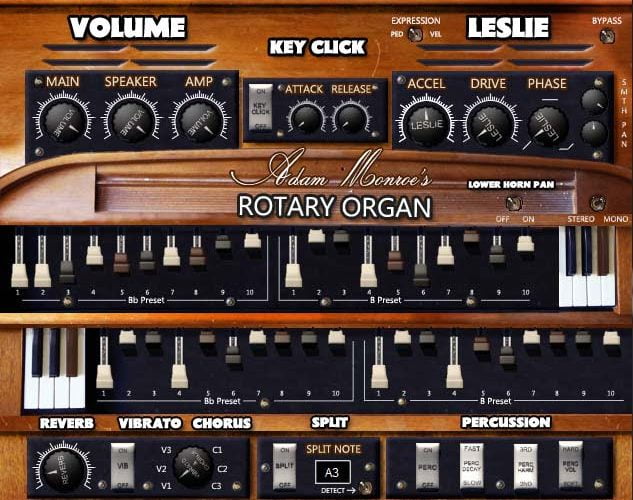
Adam Monroe Music Rotary Organ v2.5 WiN MacOSX
Team DECiBEL | WiN: 616.74 MB | MAC: 1.49 GB
Adam Monroe 的 Rotary Organ 采样自 Hammond M3 音轮风琴。最终目标是在 VST/AU/AAX 插件中模拟带有旋转 Leslie Speaker 的 Hammondnd B3 风琴的声音。每个音符上的每个拉杆都通过风琴的内置扬声器通过 Neumann TLM 102 麦克风单独采样。
信号通过 Fender Deluxe Reverb 重新放大并通过 Sennheiser e906 录制。两个信号都通过 Grace M101 前置放大器。 Hammond M3 风琴将最后两个和声组合成一个拉杆,这个音符被省略了。相反,使用“数字折返”技术将 Hammond M3 的谐波扩展到类似于 Hammond B3 的谐波。
管风琴的范围扩大到类似于 Hammond B3 的范围。这是通过使用风琴的踏板音调添加较低八度音符来实现的。
Leslie Speaker 模拟旨在模仿真实的 Leslie。信号以大约 600 Hz 的频率被分成虚拟底部转子和虚拟上部转子。颤音、合唱和平移处理用于模拟转子的旋转。上部转子在 48/409 RPM 之间旋转,底部转子在 40/354 RPM 之间旋转。可以绕过底部转子旋转。也可以绕过 Leslie 模拟。
B3 效果也进行了数字模拟,包括打击乐、颤音和按键点击。颤音扫描仪类似于 B3,包括颤音和颤音+合唱。通过向攻击和释放样本添加随机噪声来模拟按键点击。在原始样本中可以听到一些按键咔嗒声,但效果被夸大了。打击乐是在 VST 中模拟的,就像在现实生活中一样:通过 2 次或 3 次谐波向乐器添加了更高幅度的打击乐衰减声音。该插件还包括混响、制动、可变加速、驱动/失真、平滑、可调立体声声像、键分离和预设切换。
Adam Monroe’s Rotary Organ was sampled from a Hammond M3 tonewheel Organ. The end goal was to simulate the sound of a Hammondnd B3 organ with rotating Leslie Speaker inside of a VST/AU/AAX plugin. Every drawbar on every note was sampled individually via the organ’s built-in speaker through a Neumann TLM 102 microphone.
The signal was re-amped though a Fender Deluxe Reverb and recorded via a Sennheiser e906. Both signals were run through Grace M101 preamps. A Hammond M3 Organ combines the last two harmonics into a single drawbar, this note was omitted. Instead, a “digital foldback” teqchnique was used to extend the harmonics of the Hammond M3 to be similar to that of a Hammond B3.
The organ’s range was augmented to be similar to that of a Hammond B3. This was accomplished by using the Organ’s pedal tones to add the lower octave notes.
The Leslie Speaker simulation was designed to mimic a real Leslie. The signal is split to a virtual bottom rotor and virtual upper rotor at around 600 Hz. Vibrato, chorus, and panning processing are used to simulate the rotation of the rotors. The upper rotor spins between 48/409 RPM’s and the bottom rotor spins between 40/354 RPM’s. Bottom rotor rotation can be bypassed. The Leslie simulation can also be bypassed.
B3 effects where also digitally simulated and these include percussion, vibrato, and key click. Vibrato scanner is similar to that of a B3 and includes vibrato as well as vibrato+chorus. Key click was simulated by adding random noise to the attack and release samples. Some key click can be heard in the original samples but the effect has been exaggerated. Percussion was simulated in VST as it is in real life: a higher amplitude, percussive decaying sound is added to the instrument via the 2nd or 3rd harmonic. The plugin also includes reverb, braking, variable acceleration, drive/distortion, smoothing, adjustable stereo panning, key-splitting, and preset switching.
ENGINEERING:
The instrument was equalized to sound slightly more aggressive than a typical Hammond organ and therefore has the potential to stand out more in a mix. This can be adjusted with the “smoothing” knob, which will attenuate some of the harsher frequencies
Inside the VST the amp and speaker signals go through preamp/gain staging whether or not the Leslie bypass is engaged. The plugin requires a decent CPU – at least an Intel Core I3. This is because internally each harmonic is being summed for each note – which can include things like percussion and key click – meaning that each note requires upwards of 22 voices. Internally the VST is capped at 330 voices, which is equivalent to 15 notes of polyphony. The voicelist also requires extra processing power, as (unlike a piano or other percussive instrument) each not can be sustained indefinitely, and thus newer notes must work around this limitation.
The plugin also does a fair amount of internal eq and sonic shaping depending on the preset. A great deal of time was spent experimenting and finding useful drawbar settings and eq combinations. There are 32 built-in presets modeled after classic Hammond Organ drawbar settings. You can hear an audio demonstration of these presets in the mp3 section.
The memory footprint of the plugin is around 400 MB. All of the plugin’s samples are loaded into memory upon loading as the plugin is primarily comprised up of looped samples, padded out with short attack and release samples. This means that this particular plugin is not dependent on a fast hard drive as it does not need to buffer samples during execution.
The plugin is designed to work with VST AU and AAX native versions and a Kontakt version was not created. This is because the plugin relies heavily on internal programming – for everything from the Leslie simulation to sample fold-back – that would be impossible to replicate with the Kontakt player’s simple scripting language.
This VST is, essentially, a hybrid between a Hammond M3 and B3 with a more aggressive sound. It is meant to sound a bit unique to already existing plugins and simulations, but with the wide range of parameter combinations, many sounds are possible.
Release v2.5 3/15/2021
– Added Cabinet and Reverb Impulse Responses.
– Added 20 new presets.
– Added Reverb Size, Length, Wet, Dry Knobs, as well as Cabinet Wet/Dry Knobs.
– Changed the following presets: Like a Rolling Stone, Born to Be Wild, Hush
Evil Ways, Gimme Some Lovin.
– MacOS Big Sur/Arm64, and independent Mojave, Sierra, and Catalina versions.
– Changed sample loading to multithreaded, eliminated splash window (hopefully
this fixes problems with Ableton reloading projects).
Home page – https://adammonroemusic.com/organ-vst/am-organ-vst-plugin.html
